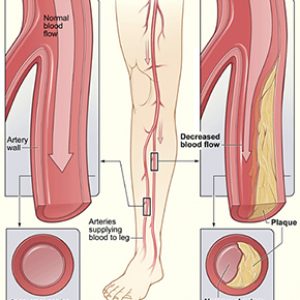Peripheral Artery Disease
Peripheral artery disease (PAD) alludes to maladies of the veins situated outside the heart and cerebrum. They are regularly caused by a development of greasy stores in the courses. PAD is otherwise called Peripheral Arterial Disease or peripheral vascular disease (which incorporates the two supply routes and veins).
PAD influences the veins making them tight, along these lines confining the blood stream to the arms, kidneys, stomach, and most ordinarily, the legs.
Peripheral artery disease also called peripheral arterial disease, is a typical circulatory issue in which limited courses diminish blood stream to your appendages.
You regularly can effectively treats peripheral artery disease by stopping tobacco, eating a healthy diet and exercising.
Peripheral Artery Disease facts
• The most ideal approach to Prevent Peripheral Artery Disease ( PAD) is by participating in physical action.
• The most regular reason is a development of cholesterol in the arteries.
• Peripheral artery disease is a danger factor for more genuine cardiovascular occasions.
• Symptoms of Peripheral Artery Disease (PAD) incorporate lack of feeling and misery in the legs.
Claudication indications incorporate muscle torment or cramping in your legs or arms that is activated by action, for example, strolling, yet vanishes following a couple of minutes of rest. The area of the agony relies upon the area of the obstructed or limited supply route. Calf torment is the most widely recognized area.
The seriousness of claudication differs generally, from mellow uneasiness to weakening torment. Extreme claudication can make it difficult for you to walk or do different kinds of physical action.
Signs and Symptoms of Peripheral artery disease :
• Painful cramping in either of your hips, thighs or lower leg muscles after specific exercises, for example, strolling or climbing stairs (claudication)
• Leg deadness or shortcoming
• Coldness in your lower leg or foot, particularly when contrasted and the opposite side
• Slower development of your toenails
• Shiny skin on your legs
• No beat or a feeble heartbeat in your legs or feet
• Erectile brokenness in men
• Sores on your toes, feet or legs that won’t mend
• A change in the shade of your legs
• Hair trouble or slower hair development on your feet and legs
Risk factors
Here the following factors are that increase your risk of developing peripheral artery disease
• Smoking
• Diabetes
• Obesity (a weight list more than 30)
• High circulatory strain
• High cholesterol
• Increasing age, particularly subsequent to achieving 50 years old
• A family history of fringe corridor malady, coronary illness or stroke
• High levels of homocysteine, a protein segment that enables fabricate and keep up to tissue
Causes of peripheral artery disease(PAD)
Most Common Cause – for PAD is atherosclerosis. Atherosclerosis is a steady procedure in which a greasy material develops inside the supply routes.
Less Common Cause – of peripheral artery disease are blood clumps in the corridors, damage to the appendages, and bizarre life structures of the muscles and tendons.
How peripheral artery disease Diagnosed ?
There are a few different ways PAD can be analyzed, if the sickness is suspected, the specialist will at first check the patient’s legs.
Lower leg brachial list – the most well-known test for PAD, it is a test that thinks about the circulatory strain in the lower leg with the pulse in the arm.
Angiography, Ultrasound output and blood tests – may in like manner be recommended to check levels of cholesterol, homocysteine, and C-open protein.
Doppler and ultrasound (Duplex) imaging – a non-nosy method that photos the vein with sound waves and measures the circulatory system in a course to demonstrate the proximity of a blockage.
Enrolled tomographic angiography (CT) – another non-meddling test that photos the supply courses of a patient’s gut, pelvis, and legs. This test is particularly profitable in patients with pacemakers or stents.
Alluring Resonance Angiography (MRA) – gives tantamount information to that made by a CT channel, yet without the necessity for X-pillars.
Angiography – this is typically saved for use in conjunction with vascular treatment techniques. Amid an angiogram, a differentiation operator is infused into the vein and X-beams are taken to indicate blood stream and to pinpoint any blockages that might be available.
Undiscovered or untreated PAD can be hazardous; it can prompt agonizing side effects, loss of a leg, expanded danger of coronary vein sickness, and carotid atherosclerosis (a narrowing of the conduits that supply blood to the cerebrum).
Since individuals with PAD have an expanded danger of heart assault and stroke, the American Heart Association urges individuals in danger to examine PAD with their specialist to guarantee early conclusion and treatment.
Preventation of peripheral artery disease
The most ideal approach to prevent claudication is to keep up a sound way of life. That implies:
• Stop smoking in case you’re a smoker.
• On the off chance that you have diabetes, keep your glucose in great control.
• Exercise routinely. Go for 30 to 45 minutes a few times each week after you’ve gotten your specialist’s OK.
• Lower your cholesterol and circulatory strain levels, if material.
• Eat sustenances that are low in immersed fat.
• Keep up a solid weight.


